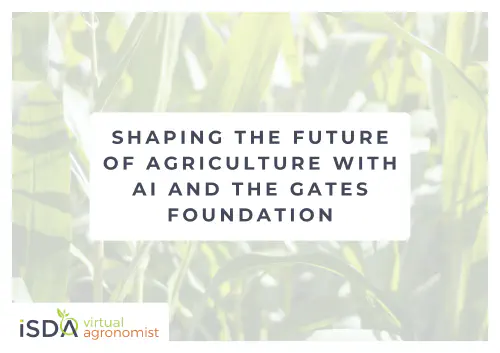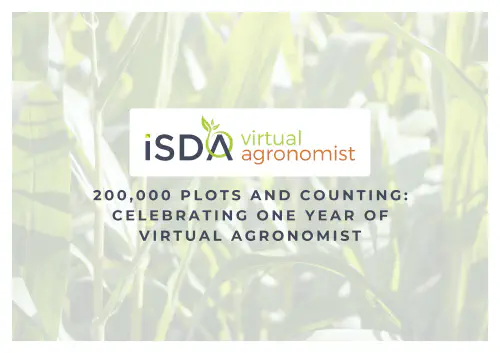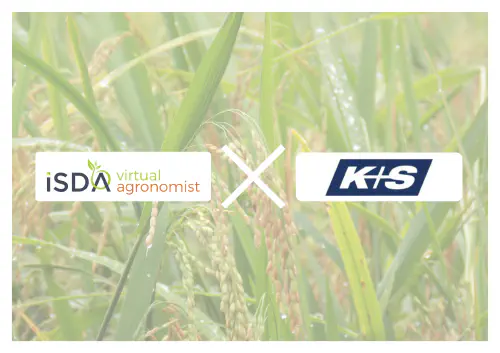On 26th February 2021 the iSDA team demonstrated the prototype app “Virtual Agronomist” to the International Fertilizer Association (IFA). The recorded webinar is available to view on YouTube.
Presenting and answering the many user questions were members of the iSDA team: Jonathan Crouch, CEO; Jamie Collinson, CTO; Monica Cross, Head of Operations; Matt Miller, Lead Data Scientist; and Keith Shepherd, Head of Diagnostics and Decision Science. The webinar was chaired by Achim Dobermann, Chief Scientist at IFA.
The program proceeded with a live demonstration of iSDAsoil, the online resource for soil nutrient mapping at 30m resolution. The map shows detailed data layers and the related uncertainty for each metric.
iSDAsoil is not just a map and reference resource, but a digital platform upon which other tools can be built. The infrastructure has been designed so that it can be rapidly updated over time. The prototype Virtual Agronomist app is one example of how the map is being used to make digital tools to help agronomists and extension agent advisors to make better recommendations to farmers.
The Virtual Agronomist
This Android application is still in prototype and is not yet for general release. It is being tested at iSDA and by integrating into our partners’ systems.
The app is designed to provide recommendation on realistic crop yield and balanced fertiliser rate and formulation, at the farm level and for larger areas. The prime audience are the extension agents, advisors, and aggregators. We built it with an interactive approach, so that the farmer can as “what if” questions to refine their needs.
Key features of the app are the combination of information from multiple sources, such as soil information, scientific principles, farmer knowledge (yields, cropping, and manuring history), weather and pest or disease forecasts, and price uncertainty. The additional representation of uncertainty factors caters for the risk preference of the farmer, so that they can select strategies that are more or less risky for their level of investment.
Using Bayesian networks, the app is robust under limited or incomplete data. Combining expert local knowledge and data together always gives you a better answer than either alone.
Soil information options for fertiliser recommendation
We have various options for soil information, but we start by selecting the location and leveraging the iSDAsoil map. Therefore, you can start with a good approximation of what to expect in your area. If you have done soil analyses at any level of expense, from spectral scans, lab-based soil testing, or omission trial data, you can enter that and get an even more accurate fertiliser prediction.
Through the next screens you incorporate local information, and this is important for getting a better result. Here the virtual agronomist uses the same approach as the real agronomist would do in the field. For example, the farmer can give you some idea of what the unfertilised yield is, and the best yield other farmers have achieved in the area. We can also ask extra questions about crop history. Next, by entering forecast information for weather and other factors the system will give you a realistic target yield. This narrows down the uncertainty from the previous data and based on soil properties it will give you a fertiliser recommendation. Including formulation, cost, and most importantly what we think the profit should be.
“You’ll notice that at no point did I enter a target yield. That’s the usual way some of these tools work, but we think that’s not the right way round. We want to enter the information and have the tool suggest it.” Jamie Collinson
Risk management for the farmer
Individual farmers may have more or less to spend, or be more adventurous. If they have more to spend they might make more profit, but they are also risking more. This is where the agent can discuss things. To go back and change options and see the effect on the result.
Sometimes spending more reduces risk. It takes you out of having low or negative return to yield. It’s a question of understanding the trade-offs between risk and return and interacting with the farmers to give them a better understanding of that trade-off.
Key differences to existing agronomy tools
There are thousands of agronomic advisory apps out there for smallholders, but the vast majority are based on data which is missing essential elements of the story. We are explicitly including uncertainty and risk, including economic risk. The way that we combine expert knowledge with scientific principles and available data using the Bayesian network technology is also unique.
Future improvements
We are particularly interested in taking this to people with the commercial interest for better support of smallholders, and aggregators for example. We would like to integrate all factors limiting yield, such as pests and diseases. And diagnosing other factors contributing to poor yield, whether it’s poor weeding or soil structural constraints.
We feel strongly that the role of the intermediary, the agent, is very important. We are concerned with finding solutions that are scalable. Harnessing science and technology to achieve deep impact, and to increase smallholder profitability, not just productivity.
Partner with iSDA
We are looking for partners who have a strong relationship with smallholders and who want to build on that loyalty. We are especially looking for agribusinesses who are providing bundled services over years, especially credit to harvest. Get in touch if you would like to work on an application trial.



